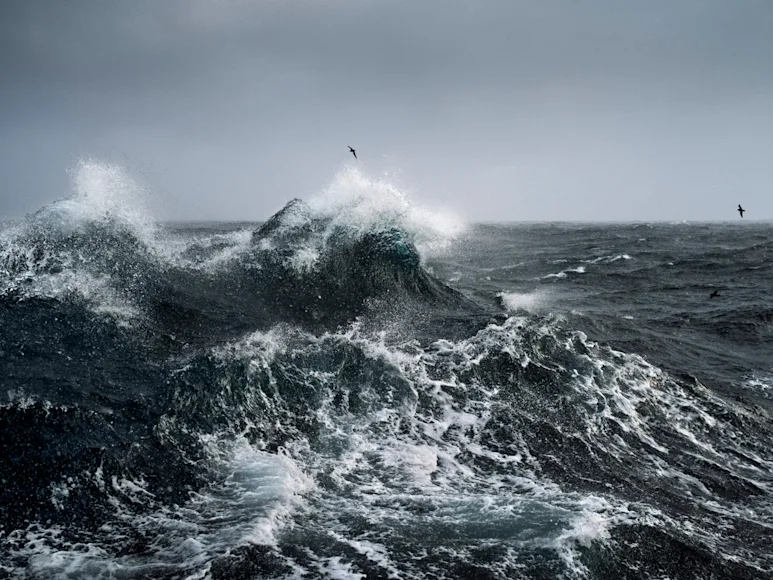Editor’s Note: The first issue of the all-new Field & Stream print journal
_includes a feature titled “Holy Waters,” a collection of six essays written by Phil Bourjaily, T. Edward Nickens, Will Brantely, and others. Here’s an online exclusive of one of the essays. To read the others, you can become a member of the 1871 Club
, or purchase an individual copy of the journal here
._
I’m ancient, but I’m not an ancient mariner, even though I grew up a few miles from the Atlantic Ocean and have fished the Atlantic and the Pacific. Some people love the ocean. I do not. In the back of my mind there’s always the thought that you can drown in it, and that it’s filled with things that want to devour you. This is not paranoia. There are 100,000 fishing-related deaths worldwide every year, and 300 fishermen take up residence in Davy Jones’s locker -every day.
Some seas, I grant you, are beautiful to look upon. I have gazed out on the Pacific from the beach at Midway Atoll, and it was indeed blue, and scenic to a fault. But it was also swarming with tiger sharks that migrated there to feed on recently hatched Laysan albatross chicks, which were taking to the ocean knowing how to swim but not fly.
My uncle was a naval officer during World War II and had survived a typhoon while navigating that same Pacific. It was, he said, the most scared he got during the entire war, including during bombing by the Japanese. You could shelter from the bombs, but there was nowhere to hide from a typhoon.
As a young boy, I heard the story of how, in the 1930s, not far from where I lived, an ocean liner named the Morro Castle washed up on the New Jersey shore at Asbury Park after catching fire at sea. More than a hundred passengers and crew died. It was a stark reminder that if something happens to your ship, you cannot run to safety. You can, however, choose between drowning and burning to death.
And so, I grew up viewing the ocean, any ocean, as something you could admire, but it was best to know where the life jackets were stowed—an idea fully cemented the day I first beheld the -Bering Sea, about 20 years ago.
***
The Bering Sea, and its northernmost extension, the Bering Strait, form the barrier between the North American and Eurasian continents. I got to visit the Bering because I was in Alaska to hunt caribou and had gotten one, so a couple of other tagged-out friends and I went beachcombing. It was a gloomy, overcast day with a cold wind blowing, which was a perfect complement to the Bering, whose weather has been described as a continual storm with occasional breaks.
The Bering seems designed to be lethal. The water is a steady 34 degrees. Survival in it is not possible for much more than a few minutes. If you go in without an immersion suit, you’ll be hypo-thermic within 15 minutes and dead within 30. In the Bering Strait, when the air temperature reaches a windchill of minus 65 degrees, the water freezes, but not all of it, so if you try to walk across, you won’t.
On the Bering Sea, there are gale force winds, sudden storms, floating ice, and long distances that can make rescue impossible. There is freezing spray, which must be continually knocked off a boat’s superstructure or it will capsize. Much of the Bering Sea is shallow. This produces waves that break with terrific energy. Some of these take the form of “confused seas,” where the winds make rapid direction shifts and the waves come at you from constantly changing directions. This means that the person at the helm can’t simply head into the waves to ride out a stretch of rough water, because in an instant, the seas can shift from the bow to starboard or port, and if you’re slow to react, over you go—and down you go.
All told, you’d be hard pressed to find a deadlier stretch of salt water.
***
Fresh water, for whatever reason, does not spook me. I’ve been out in small boats in bad weather on huge lakes in Canada and never turned a hair. But the ocean….
In 2000, I did a lot of fishing, much of it with commercial fishermen who worked salt water. To a man, they either knew someone who had died at sea, were related to someone who had not come home, or had a very close call themselves. (One skipper was due to ship out on a tuna boat, got a queasy feeling at the dock, and refused to go. The boat and crew vanished.)
But on the Bering Sea shore where we walked that day, all was tranquil. Beachcombing the Bering can show you all sorts of odd things: century-old Japanese glass net floats, parts of ships, walrus tusks, whale bones, and possibly even mammoth ivory.
What we found, however, was a reminder that this is a place where pity never shows its face and mercy is a stranger. It was a ringed seal pup that had lost its mother and was near death from starvation. Crouched against the wind nearby was a fox, waiting for the little seal to die so it could begin eating.
That was the Bering Sea in a nutshell.
I prefer dry land.


